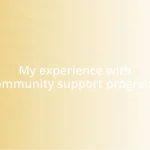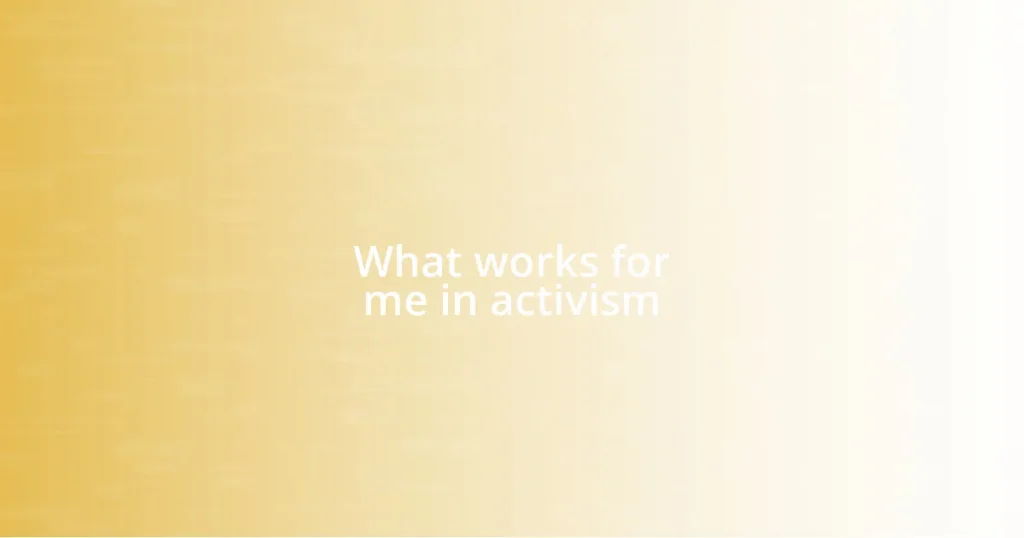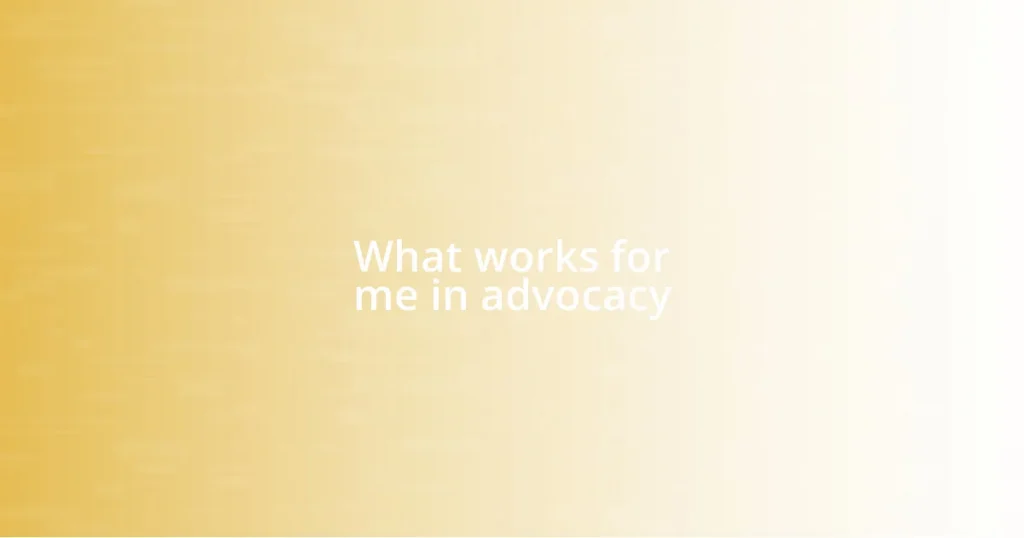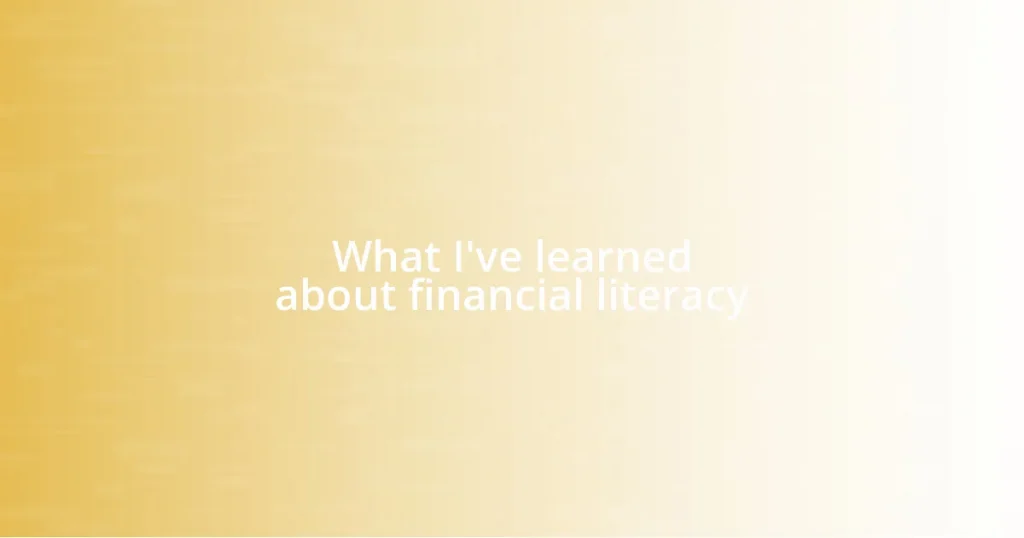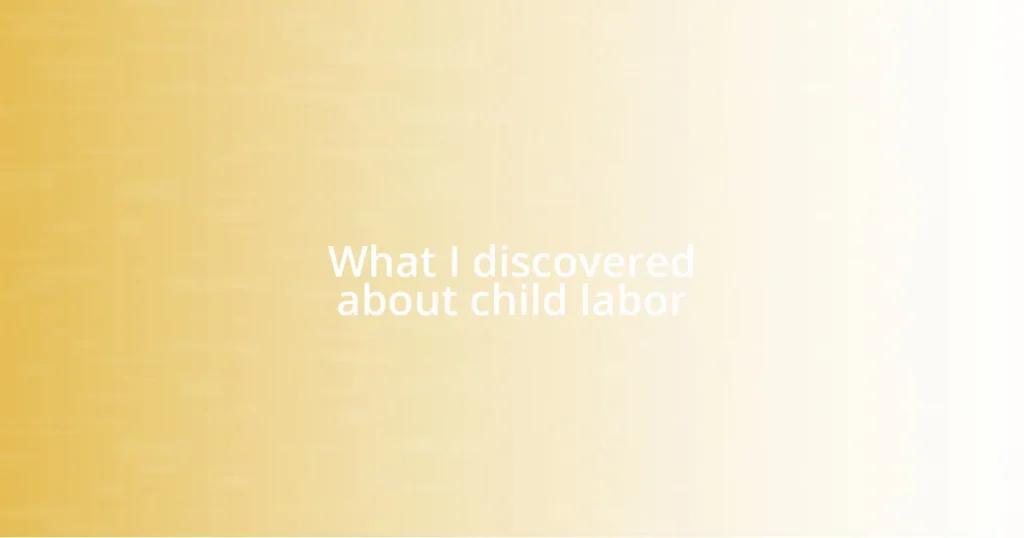Key takeaways:
- Starting the activism journey through community engagement ignited a passion for advocacy and highlighted the importance of unity.
- Identifying personal values and passions is essential for effective activism, providing direction and enhancing enthusiasm.
- Building a supportive community is crucial for motivation and collaboration, as shared experiences enrich the activism journey.
- Measuring outcomes involves both quantitative metrics and qualitative impacts, reminding us that personal stories and community shifts signify real success.

Understanding my activism journey
My activism journey began when I stumbled upon a local community meeting about climate change. I remember feeling a surge of both anxiety and excitement as I listened to passionate speakers share their stories and strategies. It made me question: What role do I play in this larger narrative?
Reflecting on those early days, I can still feel the thrill of taking that first step, a small act that opened the door to a world of advocacy. There was a moment when I organized my first event. It was daunting yet exhilarating. What if no one showed up? But when I saw a crowd gathered, all eager to engage, I realized the power of unity in action.
As I navigated through various campaigns, I often found myself grappling with setbacks. I recall feeling disheartened after a significant petition I spearheaded fell flat. Yet, those moments taught me resilience—the understanding that justice requires patience and persistence. Isn’t it fascinating how these experiences, both uplifting and challenging, shape our resolve and deepen our commitment?

Identifying personal values and passions
Identifying personal values and passions is fundamental to effective activism. I remember when I first took the time to list out what truly mattered to me—things like environmental sustainability, social justice, and community empowerment surfaced almost immediately. It was as if I was peeling back layers to reveal the core beliefs that would guide my actions. This exercise not only clarified my intentions but also ignited a passion that made my advocacy feel less like work and more like a calling.
In contrast, I’ve seen friends dive into activism without defining their values first. They often found themselves overwhelmed by the sheer volume of issues out there. I once had a friend who joined every campaign, supporting causes from animal rights to education reform, but never really connecting with any of them. It wasn’t until she identified her primary values—equity and community—did she feel genuine enthusiasm for her work. That shift transformed her approach, making each project resonate on a personal level.
At its essence, knowing your values provides a compass for your activism journey. I find myself reflecting regularly on what drives me, helping me prioritize my energy. It’s powerful to harness my passions to build connections. Those connections become not just a network, but a community of shared values, enriching my experience and, ultimately, my impact in the world.
| Personal Values | Examples of Passions |
|---|---|
| Environmental Sustainability | Advocating for climate justice |
| Social Justice | Promoting equity in education |
| Community Empowerment | Supporting local initiatives |

Researching effective activism methods
Researching effective activism methods is crucial for maximizing impact. I remember dedicating a weekend to diving into various case studies online. The stories of successful campaigns illuminated the different strategies people employed, each unique to their context yet strangely relatable. It struck me how some activists devoted themselves to grassroots organizing while others utilized digital platforms, and each approach had its merits.
Here are some effective methods I’ve found in my research:
- Grassroots Organizing: Building local coalitions and mobilizing community members.
- Digital Campaigning: Utilizing social media to spread messages and connect with broader audiences.
- Educational Workshops: Hosting events to inform and empower others about specific issues.
- Strategic Partnerships: Collaborating with established organizations for greater resource sharing.
- Petition Drives: Gathering signatures to demonstrate public support and prompt policy changes.
What resonates with me most is the importance of context—what works in one community may not be as effective in another. During my exploration, I also encountered important considerations like the target audience, the nature of the issue at hand, and the resources available. It’s like piecing together a puzzle; every bit of insight matters.

Building a supportive community
Building a supportive community isn’t just beneficial; it’s essential. I recall attending a local meeting where I first connected with others who shared my commitment to environmental justice. The energy in that room was palpable; we were all there, not just to voice our concerns, but to support one another. In that moment, I realized how much more impactful our efforts felt when we were united by shared missions and friendships.
I’ve also witnessed the challenges activists face when they lack that sense of community. Once, I volunteered for a cause alone, thinking I could manage on my own. It quickly became overwhelming, and I missed the encouragement and collective problem-solving that come from being with others who genuinely understand. I found myself craving that camaraderie, as nothing fuels motivation like the shared laughter and brainstorming that happens when like-minded individuals gather.
Establishing a network of support can also involve being vulnerable. Sharing our struggles and victories can help nurture deeper bonds. I’ve learned that it’s okay to lean on others and to offer my support when they need it. Creating an atmosphere grounded in trust allows us to not only celebrate each other’s wins but also to navigate the tougher moments together. Building these connections enriches the entire activism experience, reminding us that we are never alone in our endeavors.

Leveraging social media for impact
Leveraging social media for activism has been a game changer for me, revolutionizing how I connect with others and share messages. I still remember the excitement I felt when I first shared a post about climate change on Twitter, and within minutes, it garnered a flood of support and conversations. It truly opened my eyes to the potential of digital platforms as catalysts for change, engaging a diverse audience and amplifying voices that might otherwise go unheard. Can you imagine the reach your words can have when shared online?
One time, I created an Instagram story campaign for a local clean-up initiative. By tagging friends and using relevant hashtags, we transformed a simple idea into a buzzing conversation. Everyone jumped in, sharing their own experiences and launching us into action. I realized that social media isn’t just about broadcasting; it thrives on interaction and community involvement. It was incredible to see how quickly a group of individuals could gather and mobilize efforts when fueled by digital engagement.
Ultimately, the beauty of social media lies in its ability to bridge gaps. I often think about the global conversations ignited by a single tweet or post. When I see individuals from different backgrounds coming together over a shared cause, it reinforces my belief in the power of collective action. So, why not harness this potential? Let’s utilize our online platforms to foster collaboration and solidarity, because every post shared can contribute to a larger movement.

Measuring outcomes and successes
Measuring the outcomes of our activism is crucial for understanding what truly works. I’ve found that tracking metrics, from the number of people reached through a campaign to the tangible changes resulting from a project, provides clarity. For instance, during a fundraising drive for local environmental initiatives, I noted how each dollar raised translated into specific community actions, which helped my team stay motivated and focused.
Success in activism isn’t always about the numbers, though. One memorable experience was organizing a workshop that initially attracted a small group of attendees. While I may have measured success by turnout, the real impact emerged from the heartfelt conversations and connections formed that day. Reflecting on that event, I realized that sometimes, the most profound successes are felt rather than counted; it’s in the stories shared and the seeds of inspiration planted that we see real transformation.
I often ask myself, “How do we define success?” For me, it extends beyond quantifiable results. A shift in mindset within a community or heightened awareness around an issue can signify tremendous progress. I recall when a friend shared that my advocacy efforts had inspired her to start her own local environmental group. That ripple effect is what fuels my passion, reminding me that each action, no matter how small, contributes to a larger wave of change. How do you measure your impact? Sometimes the answers lie not in statistics, but in the lives we touch along the way.

Reflecting on lessons learned
Reflecting on lessons learned in activism, I often think about the importance of adaptability. There was a time when I organized a pet adoption event, expecting the usual turnout. However, a sudden rainstorm hit, and I was faced with a choice: cancel or pivot. I chose to move the event indoors at the last minute. The result? A cozy atmosphere that encouraged more intimate conversations and connections. Sometimes you just have to roll with the punches, don’t you think? It’s those unexpected turns that can lead to fruitful outcomes.
Another lesson I’ve learned is the significance of authentic storytelling. At one protest, I invited a speaker whose personal journey with climate change deeply resonated with the audience. I was amazed at how her vulnerability turned a march into a shared experience. It made me realize that statistics and data can only go so far; it’s the stories of real people that ignite passion and commitment. Have you ever been moved by someone’s narrative? I know I have—those moments stick with us and drive us to act.
Lastly, I’ve come to appreciate the power of patience. I remember a grassroots campaign that aimed to improve local recycling programs. After months of efforts, the first glimmers of change were subtle. Some may have given up, frustrated by the slow progress, but I continued to engage with my community, fostering discussions and sharing updates. Eventually, we saw a significant increase in participation, which reinforced my belief that lasting change takes time. Doesn’t it feel rewarding when persistence pays off? It’s a key takeaway that I hold dear in my activism journey.






